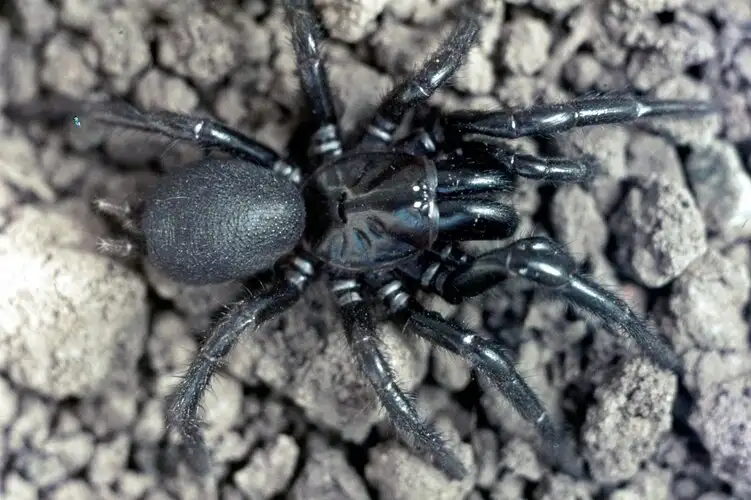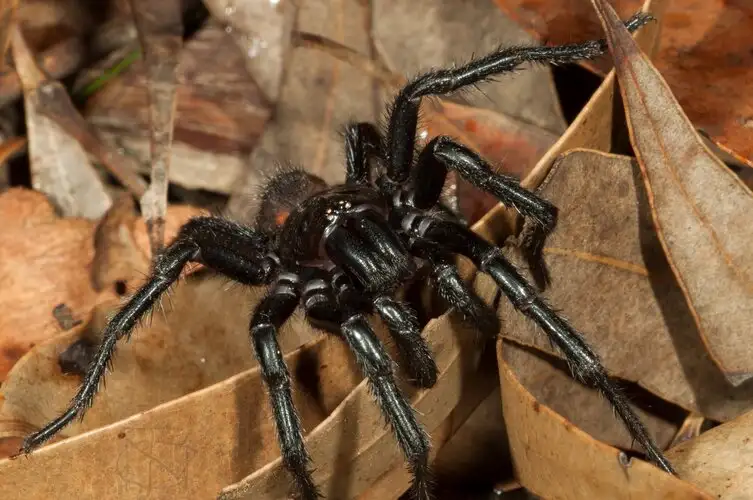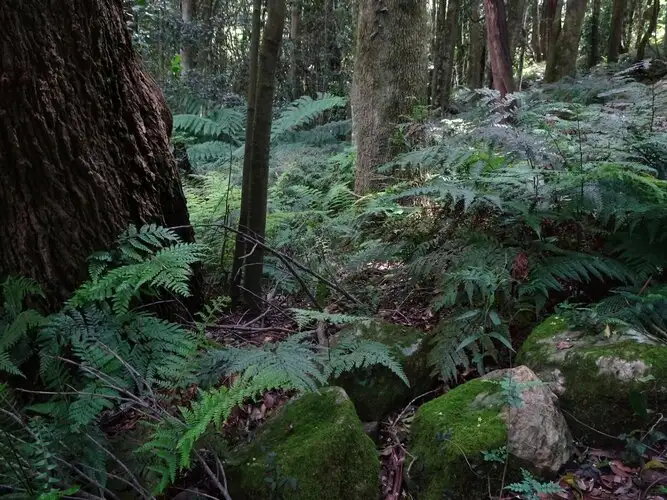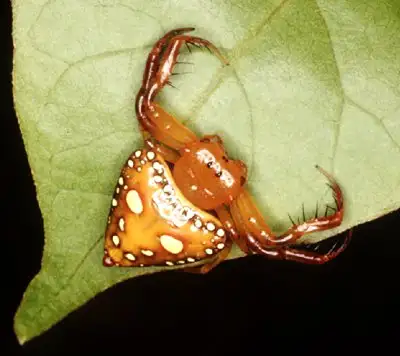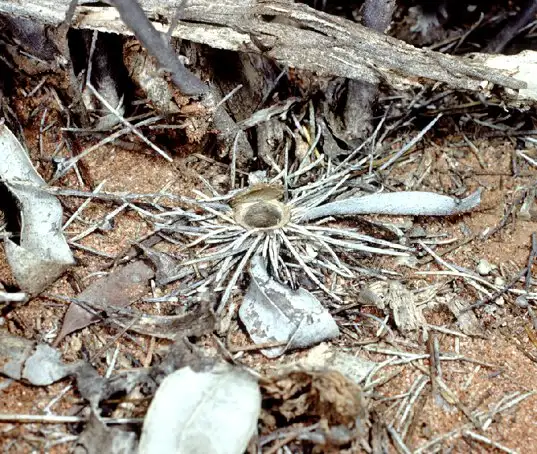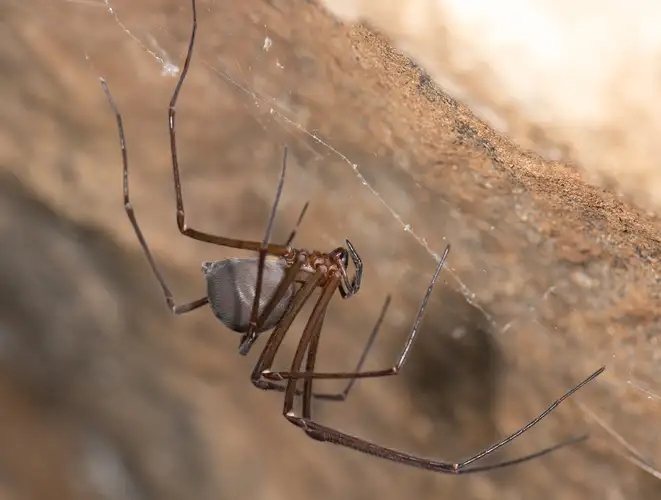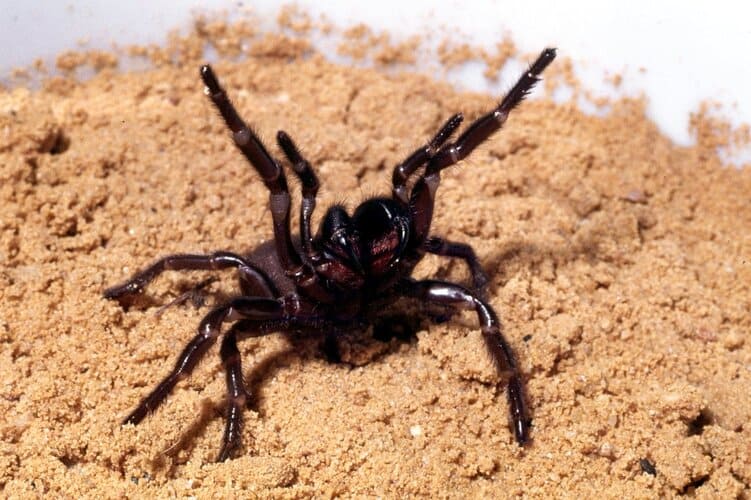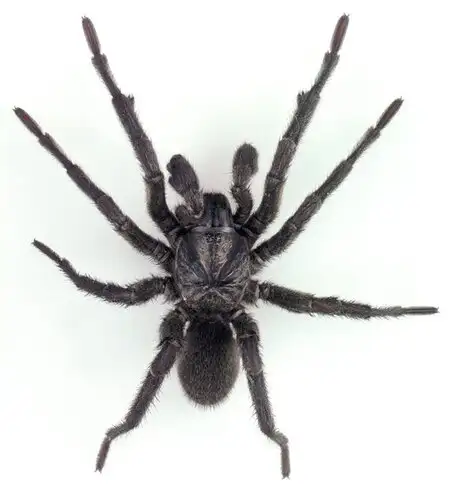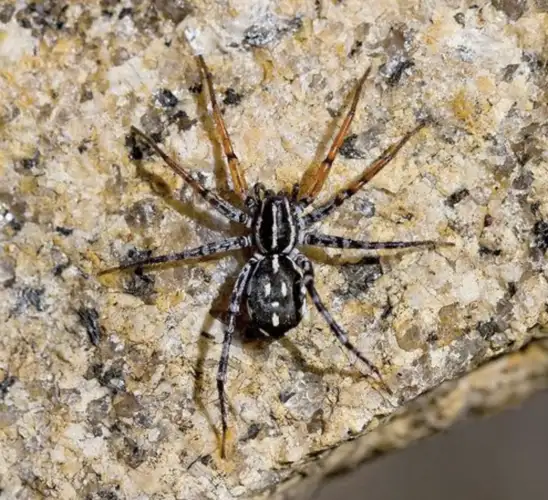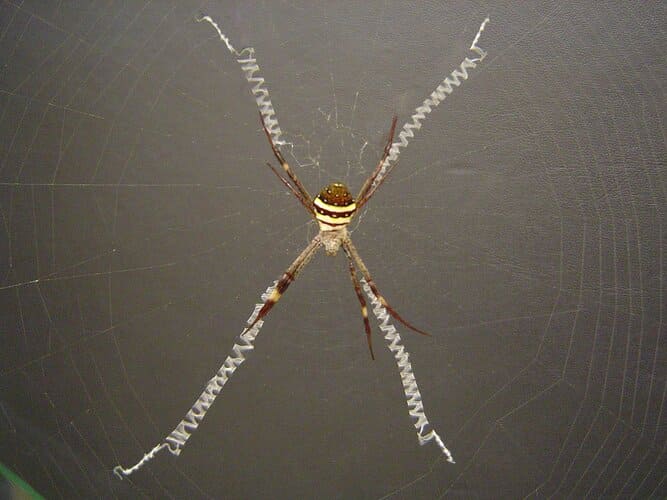Southern Sydney Funnel-web Spider
IUCN
LCBasic Information
Scientific classification
- name:Southern Sydney Funnel-web Spider
- Scientific Name:Atrax montanus Rainbow, 1914
- Outline:Arthropoda
- Family:Atracidae Atrax montanus
Vital signs
- length:Adults about 2–3.5 cm in body length; females stockier, males more long-legged; leg span around 5–7 cm
- Weight:Medium to large mygalomorph spider; body mass typically a few grams depending on sex and size
- lifetime:Long-lived for a spider; females may remain in the same burrow for many years and could live 10–20 years in suitable conditions
Feature
Highly venomous Australian funnel-web spider endemic to New South Wales, building silk-lined burrows with funnel-shaped entrances and trip-lines to ambush prey.
Distribution and Habitat
Moist forests, rainforests, gullies, rocky slopes and peri-urban gardens in southern and western parts of the Sydney region and the Blue Mountains of New South Wales.
Appearance
Glossy blue-black to dark brown carapace and legs with a slightly duller greyish-black abdomen; finger-like spinnerets and robust fangs; females stout, males more slender with longer legs.
Details
The Southern Sydney Funnel-web Spider (Atrax montanus) is a large, highly venomous mygalomorph spider in the family Atracidae. It is closely related to the famous Sydney Funnel-web Spider (Atrax robustus) and, together with the Newcastle Funnel-web (Atrax christenseni), forms part of the recently recognised “Sydney funnel-web complex”. For many years Atrax montanus was treated as just a regional form of A. robustus, but modern studies have confirmed it as a distinct species.
Taxonomy & Naming
Common name: Southern Sydney Funnel-web Spider
Scientific name: Atrax montanus Rainbow, 1914
Family: Atracidae (Australian funnel-web spiders)
Genus: Atrax
Appearance
Atrax montanus is a medium-to-large, glossy dark spider that looks very similar to the better-known Sydney Funnel-web:
Body size: adults are around 2–3.5 cm in body length; females are stockier and slightly larger, while males have longer legs and a more slender build. Leg span can reach 5–7 cm;
Colouration: the carapace and legs are shiny blue-black to dark brown, with a slightly duller, greyish black abdomen;
Surface texture: the carapace appears smooth and almost hairless, giving a polished look, while the abdomen and legs bear short hairs;
Spinnerets: finger-like posterior spinnerets at the end of the abdomen are a characteristic feature of Australian funnel-web spiders;
Sexual dimorphism: males have modified palps and a tibial spur used during mating and are the individuals most often encountered wandering in human environments.
Distribution & Habitat
The Southern Sydney Funnel-web Spider is endemic to New South Wales, Australia. Its range lies mainly to the south and west of the Sydney metropolitan area, including parts of the Blue Mountains and adjacent highland regions. Within this range it overlaps with, but is distinct from, the distribution of A. robustus.
Typical habitats include:
Moist forests, rainforests and sheltered gullies in hilly or mountainous terrain;
Forest edges, walking tracks and rocky slopes with deep leaf litter;
Rural and peri-urban gardens and lawns, especially where stones, logs and retaining walls provide cover;
Soils that remain cool and moist and are suitable for burrow construction.
The species favours cool, humid microhabitats close to the ground, where its burrows are protected from heat and drying winds.
Burrows & Funnel-web Structure
Like other Atrax species, the Southern Sydney Funnel-web builds silk-lined burrows in the soil, often under rocks, logs or tree roots. At the entrance it forms a short funnel-shaped silk tube from whichtrip-lines radiate across the surrounding leaf litter or soil:
The burrow may branch and can extend several tens of centimetres underground;
The silk at the entrance helps retain moisture and transmits vibrations from passing animals;
Females usually stay in the same burrow for many years, while males leave their burrows when mature to search for mates.
Behaviour & Diet
The Southern Sydney Funnel-web Spider is a predominantly nocturnal ambush predator:
By day it usually remains inside the burrow, often with the entrance loosely sealed;
After dark it waits near the funnel entrance, with its legs resting on the trip-lines;
It feeds mainly on ground-dwelling invertebrates such as beetles, cockroaches, millipedes and snails, and may also take small lizards or frogs that wander close to the burrow.
In warm, humid weather – especially after rain – mature males become more active and may wander across gardens, paths and other human structures while searching for females. This is when encounters with people are most likely.
Venom & Medical Importance
Atrax montanus belongs to the same highly venomous group as the Sydney Funnel-web Spider. Its venom is believed to contain potent neurotoxic components that act strongly on humans and other primates, and the species is considered medically significant.
Typical features of serious funnel-web envenomation can include:
Immediate, intense pain at the bite site with clear fang marks;
Profuse sweating, salivation, nausea and vomiting;
Muscle twitching, rapid heart rate and difficulty breathing in severe cases.
Because of its close relationship to Atrax robustus, the same funnel-web spider antivenom used for Sydney Funnel-web bites is expected to be effective for Southern Sydney Funnel-web envenomation as well. Any suspected bite by a funnel-web spider should be treated as a medical emergency using pressure immobilisation and urgent transport to hospital.
Human Interactions & Safety
Within its range, the Southern Sydney Funnel-web Spider plays an important role as a native predator but must also be respected for its dangerous venom.
Recommended precautions in funnel-web country include:
Wearing closed shoes outdoors at night and avoiding bare feet on leaf litter or around rock piles;
Using gloves or tools when lifting rocks, logs or landscaping materials;
Checking shoes, clothing and bedding if they have been left on the ground or outdoors;
Learning basic first aid for funnel-web bites and seeking urgent medical help if a bite is suspected.
References
Isbister, G, Gray, M, Balit, C, Raven, R, Stokes, B, Porges, K, Tankel, A, Turner, E, White, J, and Fisher, M. 2005. Funnel-web spider bite: a systematic review of recorded clinical cases. Medical Journal of Australia 182(8): 407-411.
Gray, M. 2010. A revision of the Australian funnel-web spiders (Hexathelidae: Atracinae). Records of the Australian Museum 62: 285-392.
Loria, S.F., Frank, SC., Dupérré, N. et al. The world’s most venomous spider is a species complex: systematics of the Sydney funnel-web spider (Atracidae: Atrax robustus). BMC Ecol Evo 25, 7 (2025). https://doi.org/10.1186/s12862-024-02332-0
Crossman S, Li O. Surface Hydrology Polygons (National). Geoscience Australia, Canberra. 2015. https://pid.geoscience.gov.au/dataset/ga/83135
FAQ
Q1. How is the Southern Sydney Funnel-web Spider different from the Sydney Funnel-web?
They are very similar in appearance and were long regarded as one species. Modern genetic and morphological studies,
however, recognise Atrax montanus as a separate species that occurs mainly south and west of Sydney, whereasA. robustus is centred on the Sydney metropolitan area and Central Coast.
Q2. Is the Southern Sydney Funnel-web Spider as dangerous as the Sydney Funnel-web?
It belongs to the same highly venomous atracine group and is regarded as medically important. Although there are fewer
documented bites, its venom is thought to be of comparable concern, so any bite should be treated as a serious emergency.
Q3. What should I do if I think I have been bitten by a funnel-web spider?
Apply pressure immobilisation (as used for snakebite), keep the victim as still as possible and call emergency services
for immediate transport to hospital. If it can be done safely, containing or photographing the spider can assist identification,
but this is less important than prompt first aid.
Q4. Do Southern Sydney Funnel-web Spiders actively attack people?
They are defensive rather than aggressive: they usually bite only when threatened, cornered or accidentally contacted.
However, they adopt a striking threat posture and may deliver multiple bites if closely disturbed, so they should never be handled.

